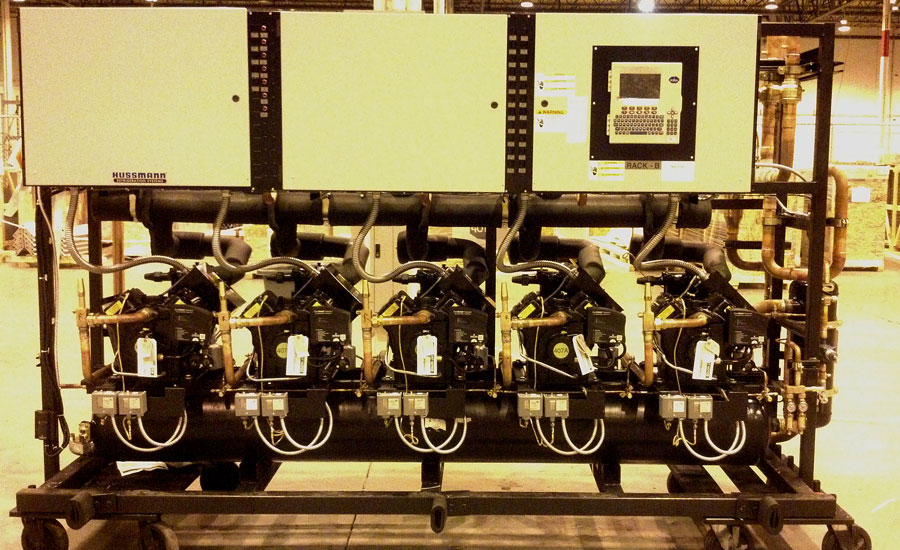Parallel compressor refrigeration racks have been the primary source of refrigeration for the grocery store industry over the years. The grocery store industry has realized that parallel rack systems offer several benefits over traditional split systems. These benefits include increased efficiency, decreased installation costs, and very accurate control. There are, however, many different applications outside of the grocery store industry where these benefits can be utilized. In this article I am going to go over the benefits a parallel rack system can offer the commercial and industrial refrigeration markets. I will then discuss the wide variety of commercial and industrial applications where parallel racks are ideal refrigeration solutions.
The focus on energy efficiency has grown over the past several years. Certifications such as Leadership in Energy and Environmental Design (LEED) and regulations such as California’s Title 24 have driven manufacturers, contractors, and end users to find ever increasing efficiencies in refrigeration equipment. Parallel compressor racks lend themselves well to this drive for increased efficiency in commercial and industrial applications.
Parallel racks are skid mounted refrigeration systems utilizing multiple compressors (see Figure 1 above).
As the refrigeration load increases, compressors will cycle on. When the load decreases, the compressors will cycle off. All of this is based on the system refrigeration load. Instead of turning one large compressor on and off using traditional condensing units, parallel racks will ramp several compressors up and down. This reduces the high electrical current inrush that a single compressor will create. Traditional split systems are on and off — all or nothing so to speak. Parallel racks can match the load from roughly 25 percent of the design load all the way to full load. The net result is increased energy efficiency. Air-cooled parallel racks can also utilize an integral controller to float the condensing temperature down when the ambient temperature drops. The net result of floating condensing temperatures is increased energy efficiency. A rack can be set up with a liquid subcooling heat exchanger to cool the liquid to where we are utilizing the entire latent heat of vaporization of the refrigerant. This too increases the system efficiency. There are several other methods to increase energy efficiency including but not limited to condenser fan cycling, demand defrost control, evaporator fan cycling, and the utilization of compressor and fan variable frequency drives (VFDs). All of these options can be utilized to fit specific applications.
Depending on the application, a parallel compressor rack can also dramatically reduce installation costs when compared to traditional split systems. A typical commercial/industrial style split system application would require several different condensing units. Each one of these units needs to be set on the roof or on a concrete slab. Once the condensing units are set, electrical power would need to be brought to each of the individual condensing units. Refrigerant piping would also need to be run to their respective evaporators or heat exchangers. A parallel compressor rack on the other hand can do the work of several condensing units. By electing to install a rack system instead of installing multiple condensing units, the contractor would only have to set the rack and an air-cooled condenser. A single point electrical power connection can be made to the rack as opposed to running power connections to individual condensing units. Electrical and control wiring can be distributed from the rack to the condenser and evaporator fans. This is a very clean way to distribute the power and control wiring resulting in a significant reduction in electrical installation costs. Refrigerant piping can be installed in a loop configuration. Instead of running individual line-sets out from each condensing unit, the installing contractor can run a single liquid and a single suction line out to multiple loads. The net result of running loop piping vs. running multiple lines is to greatly reduce the piping installation costs.
Now that I have spoken to the energy efficiency and installation advantages of a parallel rack, I would like to talk about the applications I have seen over the years. The most common application I have seen for parallel compressor racks are small to medium sized cold storage facilities. These facilities are typically less than 100,000 square feet and can include multiple coolers, freezers, and loading docks. Parallel compressor racks can be set up for multiple suction groups. A single parallel rack for a smaller facility could be designed with a low temperature suction group to provide refrigeration for the freezer as well as a medium temperature suction group to provide refrigeration for the coolers and loading dock. Dedicated low temperature and medium temperature racks can be utilized for larger cold storage facilities. Parallel racks also lend themselves very well to food processing facilities. Like cold storage facilities, food processing facilities typically have freezers, coolers, and docks. These racks would be engineered in a similar fashion as a cold storage facility taking into account the low temperature and medium temperature loads.
Cold storage and food processing facilities are the applications I have seen the most, but there are several additional applications I have seen in the past which are listed below:
• Ice plants, ice storage
• Distribution centers
• Commercial kitchens
• Spiral freezers
• Tunnel freezers
• Blast cooling
• Falling film chiller applications
• Condensing applications in the chemical and petroleum industries
• Distillation processes
• Chilled water or chilled glycol applications
• HVAC applications
In many instances, depending on the power company and area of the country, energy rebates can be obtained by installing a parallel rack versus traditional split systems for the applications I have mentioned.
Publication date: 4/18/2016
Want more HVAC industry news and information? Join The NEWS on Facebook, Twitter, and LinkedIn today!



Report Abusive Comment